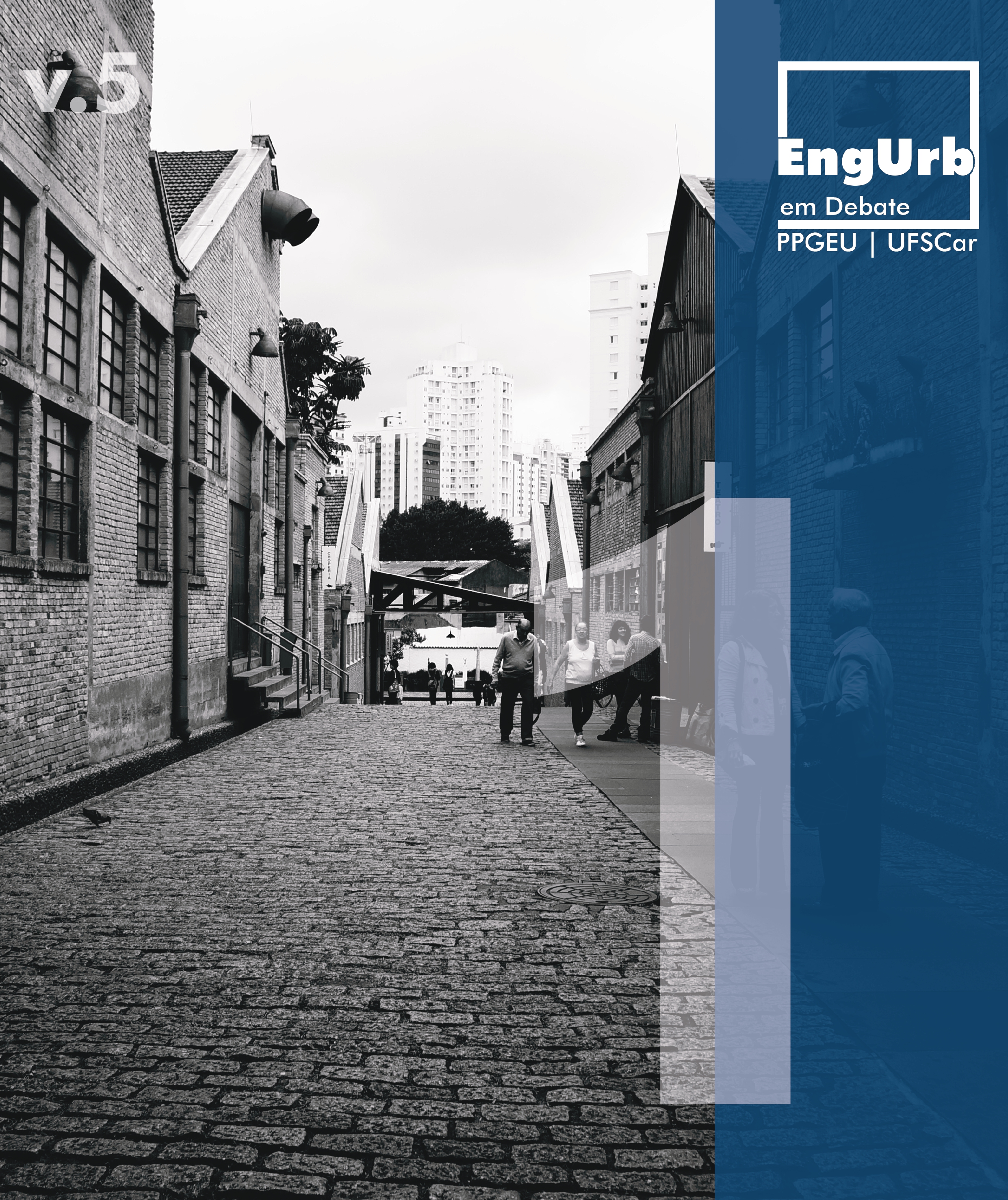INFLUÊNCIA DO BIOCARVÃO DE FIBRA DE COCO NOS PARÂMETROS FÍSICO-QUÍMICOS, TEXTURA E LIMITES DE CONSISTÊNCIA DE LATOSSOLO VERMELHO-AMARELO DE GUARATINGUETÁ (SÃO PAULO, BRASIL)
DOI:
https://doi.org/10.14244/engurbdebate.v5i1.87Keywords:
limite de liquidez, limite de plasticidade, latossolo vermelho-amarelo, retenção hídricaAbstract
Most Brazilian soils have severe water limitations for crop growth and, therefore, can benefit from organic amendments. This study evaluated the use of coconut fiber biochar (CFB) as a material for geotechnical improvement of sandy soil. For this, samples of red-yellow latosol with 10% commercial BFC were used. The samples were subjected to pH, electrical conductivity (EC), granulometry, plasticity limit (PL) and liquidity limit (LL) tests. In the pH and EC analyzes it was observed that the soil has an acidic characteristic (pH = 4.8), average ΔpH of -0.6 and EC of 41.7 µS cm-1. When adding CFB, there was an increase in pH values (mean of 6.3 and ΔpH -1.3), EC (80.7 µS cm-1), PL (3.1 to 3.3% nat soil and 3.4 to 4.1% bio soil) LL (13.9 to 17.2% natural soil and 17.2 to 19.6% bio soil). The increase in the values of LL and PL implies in the improvement of water absorption by the soil, minimizing its degradation. It is concluded that BFC is an alternative material that can be used for soil improvement, however, physical-chemical changes should be further investigated.
References
Adhikari, S.; Timms, W.; Mahmud, M. A. P. (2022). Optimising water holding capacity and hydrophobicity of biochar for soil amendment – A review, Science of The Total Environment, Volume 851, Part 1, 158043, https://doi.org/10.1016/j.scitotenv.2022.158043.
Bashir, I.; Lone, F. A.; Bhat, R. A.; Mir, S. A.; Dar, Z. A.; Dar, S. A. (2020). Concerns and Threats of Contamination on Aquatic Ecosystems. In: Hakeem, K., Bhat, R., Qadri, H. (eds) Bioremediation and Biotechnology. Springer, Cham. https://doi.org/10.1007/978-3-030-35691-0_1
Carmo, D. L. do; Silva,C. A. (2016). Condutividade elétrica e crescimento do milho em solos contrastantes sob aplicação de diversos níveis de calagem. Pesquisa Agropecuária Brasileira [online]. 2016, v. 51, n. 10, pp. 1762-1772, https://www.scielo.br/j/pab/a/vhKrBTyvQSmW8HJbTR3xhXB/?lang=pt#. Acessado em 14/12/2022.
Chang, Y.; Rossi, L.; Zotarelli, L.; Gao, B.; Shahid, M. A.; Sarkhosh, A. (2021). Biochar improves soil physical characteristics and strengthens root architecture in Muscadine grape (Vitis rotundifolia L.) Yuru. Chemical and Biological Technologies in Agriculture, Volume 8(7). https://doi.org/10.1186/s40538-020-00204-5.
EMPRESA BRASILEIRA DE PESQUISA AGROPECUÁRIA – EMBRAPA (2018). Sistema Brasileiro de Classificação de Solos. EMBRAPA Solos (5°dição). Brasília, DF. 355p.
Hussain, R.; Ravi, K. (2022). Investigating biochar-amended soil as a potential lightweight material for embankments. Ecological Engineering, Volume 180, 106645. https://doi.org/10.1016/j.ecoleng.2022.106645.
IBGE (2020). Aglomerados Subnormais 2019: Classificação preliminar e informações de saude para o enfrentamento à COVID-19. Instituto Brasileiro de Geografia e Estatística - IBGE, Rio de Janeiro, https://biblioteca.ibge.gov.br/visualizacao/livros/liv101717_apresentacao.pdf. Acessado em 14/12/2022.
Kasemodel, M. C.; Romão, E. L.; Papa, T. B. R. Adsorption of Methylene Blue on Babassu Coconut (Orbignya speciosa) Mesocarp Commercial Biochar. Research Square (Pre-print). https://doi.org/10.21203/rs.3.rs-1510328/v1
Kang, M. K.; Yibeltal, M.; Kim, Y. H.; Oh, S. J.; Lee, J. C.; Kwon, E. E.; Lee, S. S. (2022). Enhancement of soil physical properties and soil water retention with biochar-based soil amendments, Science of The Total Environment, Volume 836, 155746, https://doi.org/10.1016/j.scitotenv.2022.155746.
Kushwaha, D. P.; Kumar, A.; Chaturvedi, S. (2021). Determining the effectiveness of carbon-based stabilizers blends in arresting soil erosion and elevating properties of Mollisols soils of North Western Himalayas, Environmental Technology & Innovation, Volume 23, 101768, https://doi.org/10.1016/j.eti.2021.101768.
Ker, J. C. (1997) Latossolos do Brasil: Uma Revisão. Universidade Federal de Viçosa - Minas Gerais, https://periodicos.ufmg.br/index.php/revistageonomos/article/view/11493. Acessado em 14/12/2022.
Liao, D.; Deng, Y.; Duan, X.; Cai, C.; Ding, S. (2022). Variations in weathering characteristics of soil profiles and response of the Atterberg limits in the granite hilly area of South China., CATENA, Volume 215, 106325, https://doi.org/10.1016/j.catena.2022.106325.
Rossi, M. (2017). Mapa Pedológico do Estado de São Paulo: Revisado e Ampliado. São Paulo: Instituto Florestal, https://www.infraestruturameioambiente.sp.gov.br/institutoflorestal/wp-content/uploads/sites/234/2017/11/Livro_Solos1.pdf. Acessado em 14/12/2022.
Roy, S.; Bhalla, S. K. (2017). Role of geotechnical properties of soil on civil engineering structures. Resources and Environment, Volume 7, n. 4, pp. 103-109. https://doi.org/10.5923/j.re.20170704.03
Santos, J. A.; Gonzaga, M. I. S.; Santos, W. M.; Silva, A. J. (2022). Water retention and availability in tropical soils of different textures amended with biochar. CATENA, Volume 219, 106616. https://doi.org/10.1016/j.catena.2022.106616.
SERVIÇO GEOLÓGICO DO BRASIL – CPRM. Programa Geologia do Brasil- Mapa Geológico do Estado de São Paulo, Escala 1:750.000. Breve descrição das unidades litoestratigráficas aflorantes no Estado de São Paulo. Sem data. Disponível em: chrome-extension://efaidnbmnnnibpcajpcglclefindmkaj/https://rigeo.cprm.gov.br/bitstream/doc/2966/1/breve_descri%C3%A7%C3%A3o_unidades.pdf. Acesso em 24 jun 2023.
Downloads
Published
Versions
- 2024-09-25 (2)
- 2024-08-14 (1)
How to Cite
Issue
Section
License
Copyright (c) 2024 Leticia Santos Bezerra, Amanda Saraiva Tavares, Mariana Consiglio Kasemodel

This work is licensed under a Creative Commons Attribution-NonCommercial-ShareAlike 4.0 International License.





